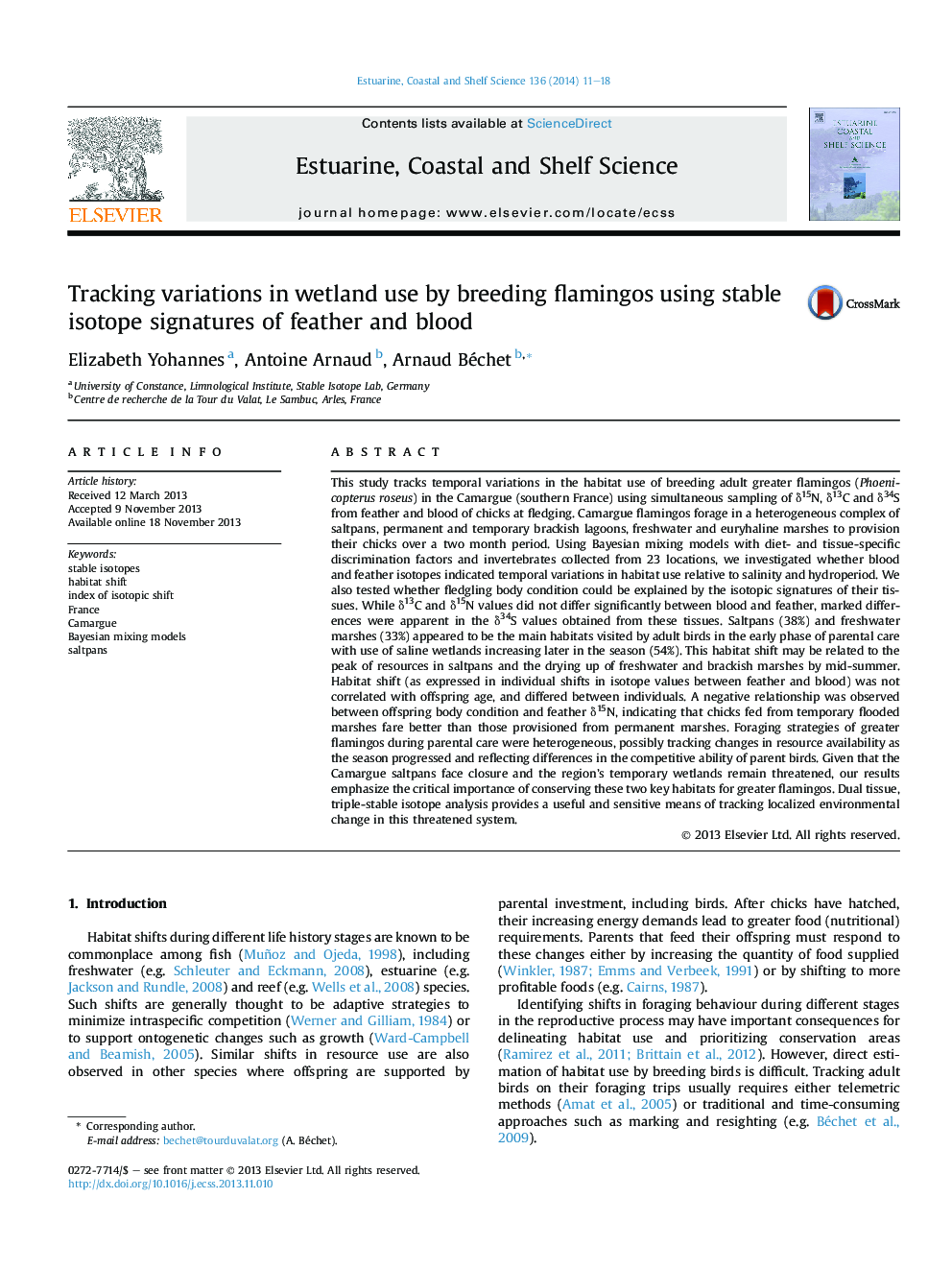| کد مقاله | کد نشریه | سال انتشار | مقاله انگلیسی | نسخه تمام متن |
|---|---|---|---|---|
| 6384989 | 1326627 | 2014 | 8 صفحه PDF | دانلود رایگان |
عنوان انگلیسی مقاله ISI
Tracking variations in wetland use by breeding flamingos using stable isotope signatures of feather and blood
ترجمه فارسی عنوان
تغییرات پیگیری در استفاده از تالاب توسط پرورش فلامینگو با استفاده از املاء ایزوتوپ پایدار پر و خون
دانلود مقاله + سفارش ترجمه
دانلود مقاله ISI انگلیسی
رایگان برای ایرانیان
کلمات کلیدی
ایزوتوپهای پایدار، تغییر محل زیستگاه، شاخص تغییرات ایزوتوپ، فرانسه، کامارگ، مدل های مخلوط کردن بیزی، نمک
موضوعات مرتبط
مهندسی و علوم پایه
علوم زمین و سیارات
زمین شناسی
چکیده انگلیسی
This study tracks temporal variations in the habitat use of breeding adult greater flamingos (Phoenicopterus roseus) in the Camargue (southern France) using simultaneous sampling of δ15N, δ13C and δ34S from feather and blood of chicks at fledging. Camargue flamingos forage in a heterogeneous complex of saltpans, permanent and temporary brackish lagoons, freshwater and euryhaline marshes to provision their chicks over a two month period. Using Bayesian mixing models with diet- and tissue-specific discrimination factors and invertebrates collected from 23 locations, we investigated whether blood and feather isotopes indicated temporal variations in habitat use relative to salinity and hydroperiod. We also tested whether fledgling body condition could be explained by the isotopic signatures of their tissues. While δ13C and δ15N values did not differ significantly between blood and feather, marked differences were apparent in the δ34S values obtained from these tissues. Saltpans (38%) and freshwater marshes (33%) appeared to be the main habitats visited by adult birds in the early phase of parental care with use of saline wetlands increasing later in the season (54%). This habitat shift may be related to the peak of resources in saltpans and the drying up of freshwater and brackish marshes by mid-summer. Habitat shift (as expressed in individual shifts in isotope values between feather and blood) was not correlated with offspring age, and differed between individuals. A negative relationship was observed between offspring body condition and feather δ15N, indicating that chicks fed from temporary flooded marshes fare better than those provisioned from permanent marshes. Foraging strategies of greater flamingos during parental care were heterogeneous, possibly tracking changes in resource availability as the season progressed and reflecting differences in the competitive ability of parent birds. Given that the Camargue saltpans face closure and the region's temporary wetlands remain threatened, our results emphasize the critical importance of conserving these two key habitats for greater flamingos. Dual tissue, triple-stable isotope analysis provides a useful and sensitive means of tracking localized environmental change in this threatened system.
ناشر
Database: Elsevier - ScienceDirect (ساینس دایرکت)
Journal: Estuarine, Coastal and Shelf Science - Volume 136, 1 January 2014, Pages 11-18
Journal: Estuarine, Coastal and Shelf Science - Volume 136, 1 January 2014, Pages 11-18
نویسندگان
Elizabeth Yohannes, Antoine Arnaud, Arnaud Béchet,
